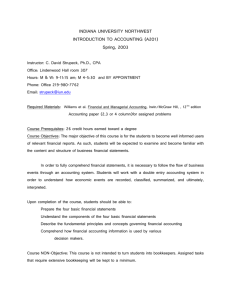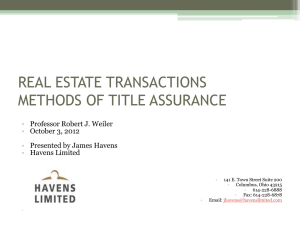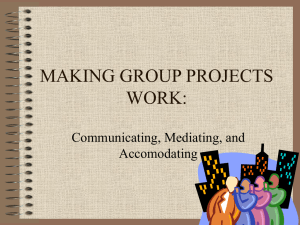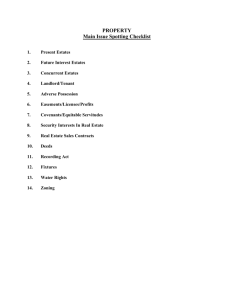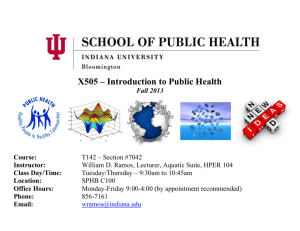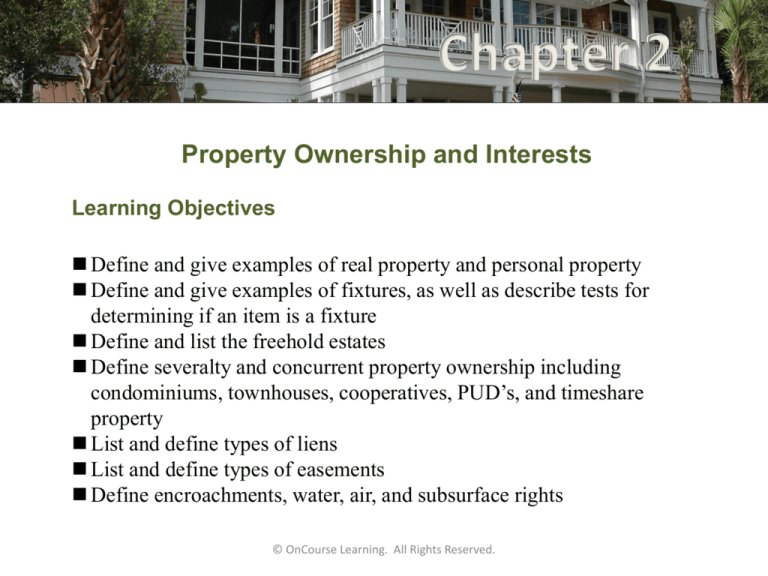
Chapter 2
Property Ownership and Interests
Learning Objectives
Define and give examples of real property and personal property
Define and give examples of fixtures, as well as describe tests for
determining if an item is a fixture
Define and list the freehold estates
Define severalty and concurrent property ownership including
condominiums, townhouses, cooperatives, PUD’s, and timeshare
property
List and define types of liens
List and define types of easements
Define encroachments, water, air, and subsurface rights
© OnCourse Learning. All Rights Reserved.
Chapter 2
Property Ownership and Interests
Real Property
Real property consists of land, improvements, rights and privileges
Conveyed by deed
Tenements and Hereditaments
Tenements include those things that can be touched and seen
(buildings) as well as things that are intangible (easements)
Hereditaments are those things capable of being inherited
Plants include fruits of the soil (fructus naturales or perennials) or
fruits of industry (fructus industrials or annuals)
Plants requiring annual cultivation are considered personal property
Plants not requiring annual cultivation are considered real property
unless in a movable container
© OnCourse Learning. All Rights Reserved.
Chapter 2
Property Ownership and Interests
Appurtenances
Rights or privileges that “runs with the land”
Subsurface Rights
Rights that exist under the surface of the earth (i.e. mineral rights)
Air Rights
Rights that exist above the surface of the earth
Limited to what the owner is reasonably expected to use
Riparian Rights
Rights of an owner bordering a flowing body of water
© OnCourse Learning. All Rights Reserved.
Chapter 2
Property Ownership and Interests
Lateral and Subjacent Support
Lateral - Right of land to be supported in it’s natural state by adjacent
land
Subjacent – Right to have land supported from below (i.e. mining)
Personal Property
Anything not considered real property
Conveyed “Bill of Sale”
© OnCourse Learning. All Rights Reserved.
Chapter 2
Property Ownership and Interests
Fixtures
Item that was once personal property that has become real property by
virtue of its’ attachment
Total circumstance test:
1. Intent – major determinant
2. Relation of the attacher
3. Method of attachment
4. Adaptation or customization
Trade fixtures – fixtures used in the conducting of commerce.
Considered personal property and can be removed at end of lease
Uniform Commercial Code – provides for a lender to have a fixture
considered personal until paid off
© OnCourse Learning. All Rights Reserved.
Chapter 2
Property Ownership and Interests
Improvements
Anything attached that increases the value or utility of the land
Can be “to the land” or “on the land”
“To the land” includes roads, utilities, grading, etc.
“On the land” includes buildings
© OnCourse Learning. All Rights Reserved.
Chapter 2
Property Ownership and Interests
Estates and Real Property
Eminent Domain
The Right to take private property for a public use by paying the
owner fair and just compensation
The actual taking of the land is considered condemnation
Police Power
The right of a government to make and pass reasonable rules and
regulations to promote and protect the public welfare (i.e. building,
fire, health, and sanitation codes)
© OnCourse Learning. All Rights Reserved.
Chapter 2
Property Ownership and Interests
Estates and Real Property
Taxation
Real property taxes is the largest source of income for local
government
Escheat
When an owner dies without leaving a valid will, and no apparent
heirs, the property will convey (escheat) to the state
© OnCourse Learning. All Rights Reserved.
Chapter 2
Property Ownership and Interests
Estates in Land
Either “freehold” or “Nonfreehold” (leasehold or less than freehold)
© OnCourse Learning. All Rights Reserved.
Chapter 2
Property Ownership and Interests
Freehold Estates
Freehold lasts for at least a lifetime
Can be inheritable or non-inheritable
Estates of Inheritance
Fee Simple Absolute:
• Also known as “fee simple” or “fee”
• The highest and best form of ownership available in real property
Fee Simple Determinable
• Grantor sets conditions on future use of real property
• Title AUTOMATICALLY reverts to grantor if conditions are violated
© OnCourse Learning. All Rights Reserved.
Chapter 2
Property Ownership and Interests
Estates of Inheritance
Fee Simple Subject to Condition Subsequent:
• Grantor sets conditions on future use of the property in some way
• Grantor, his heirs, or the remainderman must take action to regain
title if conditions are violated
• Note: Both Fee Simple Determinable and Fee Simple Subject to a
Condition Subsequent are defeasible or qualified fee estates
Estate Pur Autre Vie:
• Estate based on the lifetime of another (i.e. Person A conveys title to
Person B for the lifetime of Person C)
© OnCourse Learning. All Rights Reserved.
Chapter 2
Property Ownership and Interests
Estates of Not of Inheritance
Conventional Life Estate:
• For the life of the named life tenant
Marital Life Estate:
• Allows surviving spouse a life estate in 1/3 of real property owned
in severalty by the deceased anytime during the marriage
Dower/Courtesy:
• Wife’s/Husband’s right to a life estate in the property owned by a
deceased spouse during the marriage
• Abolished and replaced by the Marital Life Estate created by North
Carolina Intestate Succession Statutes
© OnCourse Learning. All Rights Reserved.
Chapter 2
Property Ownership and Interests
Life Estates
Conventional Life Estate:
• Created by the act of parties
• Non-inheritable freehold estate
Marital Life Estate:
• Created by the operation of law
• Governs the distribution of property for a spouse who dies intestate
• A will cannot defeat the marital interest of a surviving spouse
• Statute does not apply to property owned as tenants by the entirety
• Surviving spouse has a choice of EITHER:
• Marital life estate
OR
• Property of the deceased spouse willed to the surviving spouse
© OnCourse Learning. All Rights Reserved.
Chapter 2
Property Ownership and Interests
Life Estates
The grantor or his/her heirs will have a reversionary interest in the
estate
• At death of life tenant, estate will revert to grantor or his/her heirs
Grantor
Grantee (life tenant)
© OnCourse Learning. All Rights Reserved.
Chapter 2
Property Ownership and Interests
Life Estates
Alternatively, the conveyance of the life estate could specify that the
estate pass on to someone other than the grantor or his/her heirs (life
estate in remainder)
• This person would be called a remainderman and has a
remainder, or future, interest in the property
Grantor (in a deed)
Grantee
© OnCourse Learning. All Rights Reserved.
Remainderman
Chapter 2
Property Ownership and Interests
Life Estates – Rights of Responsibilities of Life Tenants
Right of alienation:
• Life tenant may transfer his/her title to another
• May pledge the title as security for a debt
• Note: May only transfer or pledge title to life estate, not to whole
bundle of rights
Responsibility of preservation:
• Must not commit waste
• Must preserve the estate for the benefit of the remainderman or
holder of the reversionary interest
Right of estovers:
• Allows life tenant to cut and use a reasonable amount of timber
from the land to repair buildings or to use as fuel
• Does not allow the tenant to cut and sell timber for profit
© OnCourse Learning. All Rights Reserved.
Chapter 2
Property Ownership and Interests
Life Estates – Rights of Responsibilities of Life Tenants
Responsibility for taxes:
• Has an obligation to pay the real property taxes on the property in
which he/she has a life estate
Responsibility to repair:
• A duty to make repairs to the improvements on the land
• Cannot permit the property to deteriorate due to lack of repairs
causing depreciation of improvements
© OnCourse Learning. All Rights Reserved.
Chapter 2
Property Ownership and Interests
Non-Freehold Estates
Estate for years:
• For any fixed period of time
• Automatically terminates at the end of that period
• No notice required to terminate
Estate from year to year (periodic estate):
• A periodic estate that automatically renews at the end of its period if the
parties do not provide otherwise
• Notice is required to terminate
Estate at will:
• An indefinite duration
• May be terminated by either party instantaneously by giving notice to the
other party
• Payment of rent would change this to a periodic estate
Estate at sufferance:
• A holdover situation created when the tenant’s lease has expired and
he/she fails to vacate the premises
• Differs from trespassing in that tenant originally entered property legally
© OnCourse Learning. All Rights Reserved.
Chapter 2
Property Ownership and Interests
Forms of Ownership
Ownership in Severalty:
• Title is held in the name of only one person
Concurrent (Joint) Ownership:
• Simultaneous ownership of real property by two or more people
Tenancy in Common:
• Two or more people holding title to property at the same time with no right
of survivorship
• Each tenant in common holds an undivided interest in the entire property
• These interests may be, but need not be equal
Joint Tenancy:
• Must acquire interests at the same time and on same deed
• If joint tenant sells his/her share, the new owner will become a tenant in
common
• No automatic right of survivorship in North Carolina
© OnCourse Learning. All Rights Reserved.
Chapter 2
Property Ownership and Interests
Forms of Ownership
Tenancy by the Entirety:
• Limited to ownership of husband and wife
• Right of survivorship
• Surviving spouse receives title by operation of law
• Marriage does not create tenancy by entirety for property one spouse brings
into the marriage
• One spouse may convey ownership to both spouses as tenants by the
entirety
• Both spouses must sign deed to convey property held as tenants by the
entirety to one of them in severalty
• After decree of divorce, ownership reverts to tenancy in common
Community Property:
• Not practiced in North Carolina
© OnCourse Learning. All Rights Reserved.
Chapter 2
Property Ownership and Interests
Condominiums
Includes the ownership of the airspace of the individual unit in any form of
ownership
Airspace owners own common areas as tenants in common however, the right
to partition is waived
© OnCourse Learning. All Rights Reserved.
Chapter 2
© OnCourse Learning. All Rights Reserved.
Chapter 2
Property Ownership and Interests
Combination (Hybrid) Forms of Concurrent Ownership
Condominiums
Ownership of the individual unit plus co-ownership of the common areas
The 1986 North Carolina Condominium Act
Pertains primarily to residential condominiums
Public offering statement:
• Must be provided by the developer to the prospective buyer before the
contract is signed
• Must disclose certain information pertaining to the project, including the
right to cancel
• Does not apply to resale
© OnCourse Learning. All Rights Reserved.
Chapter 2
Property Ownership and Interests
The 1986 North Carolina Condominium Act
Purchaser’s right to cancel:
• Can cancel for any or no reason, within SEVEN DAYS after signing
contract
• Does not apply to resale
Escrow of deposit:
• Deposits must be kept in an escrow account the full SEVEN DAYS or until
cancellation and refund occurs
Resale certificates:
Disclosure of monthly assessments for common areas and other fees for
which owners are responsible is required
Warranties:
• Unit is constructed in an acceptable manner, free from defects, and suitable
for the purpose intended unless warranty has been disclaimed so as to void
it
© OnCourse Learning. All Rights Reserved.
Chapter 2
Property Ownership and Interests
Combination (Hybrid) Forms of Concurrent Ownership
Townhouses
Ownership of the unit as well as the specific portion of land upon which the
individual unit is located
The Home Owner’s Association owns the common areas
Cooperatives
Ownership of shares of stock in a corporation that owns a building containing
cooperative apartments
Right of possession is provided by a proprietary lease
© OnCourse Learning. All Rights Reserved.
Chapter 2
Property Ownership and Interests
Combination (Hybrid) Forms of Concurrent Ownership
Time Shares
Any right to occupy a property for five or more separated time periods over a
span of five or more years
Purchasers must be given a public offering statement
Five day right of rescission
Escrow requirement ten days
Planned Unit Developments (PUD’s)
Small community that includes some form of housing, recreational areas, and
supporting commercial activities
Any form of residential ownership may be present; such as single-family
homes, condominiums, or townhouses
Concept of land development rather than a form of ownership
© OnCourse Learning. All Rights Reserved.
Chapter 2
Property Ownership and Interests
Encumbrances to Real Property
Liens
A claim or a charge against the property that can result from a contractual
agreement or from the operation of law
Easements
The right someone has in the lands of another
Encroachments
A trespass on the land of another as a result of an intrusion or invasion by some
structure
As disclosed by a survey
© OnCourse Learning. All Rights Reserved.
Chapter 2
Property Ownership and Interests
Classification of Liens
© OnCourse Learning. All Rights Reserved.
Chapter 2
Property Ownership and Interests
Classification of Liens
Specific Liens
Mortgage
• Pledges a specific property as security for a debt
• North Carolina uses deed of trust as security instrument
• Default on repayment of the mortgage or deed of trust note will cause
the lender to foreclose by having the property sold at public auction
• The proceeds of the sale are used to satisfy the debt
Real property tax
• Taxes levied by a local government
• This type of lien has priority over all other liens
• Real property tax liens are good for ten years
© OnCourse Learning. All Rights Reserved.
Chapter 2
Property Ownership and Interests
Classification of Liens
Specific Liens
Special assessment:
• A charge against a property for the prorata cost of some improvements
made to areas adjoining the property (i.e. street paving, water and
sewer lines, sidewalks)
Mechanic’s lien:
• A lien filed by anyone who provides labor or material to a property
• Must file within 120 DAYS from the last day that labor or material
was furnished to the property
• Effective from the first day that labor or material was furnished to the
property
• Must be enforced within 180 DAYS from the last day of work
© OnCourse Learning. All Rights Reserved.
Chapter 2
Property Ownership and Interests
Classification of Liens
General Liens
A court decree of the amount one person is indebted to another
Judgment:
• General lien against all real and personal property the judgment debtor
owes in the county in which the judgment is recorded
• May be recorded in any county in the state
Personal property tax:
• Annual tax assessed on certain personal property owned as of January
1st of the tax year
• Covered in detail in Chapter 3
Income tax:
• A general lien for federal and state income taxes
• This lien does not have a special priority
© OnCourse Learning. All Rights Reserved.
Chapter 2
Property Ownership and Interests
Classification of Liens
General Liens
Estate & inheritance tax:
• Federal government imposes a tax on the estate (real and personal
property) of deceased persons, called the estate tax
• States also impose a state inheritance tax upon the inheritance of real
and personal property
• Taxes continue until they are paid
© OnCourse Learning. All Rights Reserved.
Chapter 2
Property Ownership and Interests
Classification of Liens
Priority of Liens
Priority generally based on the time (day and hour) the lien is recorded with
those recorded first taking priority
This system is also known as the pure race system
Exceptions to this priority are:
• Real property taxes – always given priority over all other liens
• Personal property taxes – like real property taxes, given priority over all
other liens
• Mechanic’s liens – priority relates to the first date of work on the job rather
than the date of recordation
© OnCourse Learning. All Rights Reserved.
Chapter 2
Property Ownership and Interests
Classification of Easements
Appurtenant easement:
• An easement between two or more adjoining properties, owned by two or
more separate owners, and is said to, “Run with the land”
• Land that is benefited from the easement is the dominant tenement and the
land encumbered by the easement is the servient tenement
Easements in gross – not dependent upon ownership of an adjoining property.
No dominant tenement; only a servient tenement
• Commercial easements in gross are assignable and can be conveyed
• Most common use of commercial easement in gross is for the purpose of
installing power lines, telephone or cable lines, and gas lines above, on, or
under the surface of the earth
• Personal easements in gross are:
• Not assignable
• Cannot be conveyed
• Not inheritable
• Personal easements in gross are rare
© OnCourse Learning. All Rights Reserved.
Chapter 2
Property Ownership and Interests
Classification of Easements
Appurtenant easement:
• An easement between two or more adjoining properties, owned by two or
more separate owners, and is said to, “Run with the land”.
• The land that is benefited from the easement is the dominant estate and the
land encumbered by the easement is the servient estate.
Easements in gross – An easement between a parcel of land and a person or
legal entity. This involves a servient interest only.
• Commercial easements in gross are assignable and can be conveyed
• Most common use of commercial easement in gross is for the purpose of
installing power lines, telephone or cable lines, and gas lines above, on, or
under the surface of the earth
• Personal easements in gross are rare
© OnCourse Learning. All Rights Reserved.
Chapter 2
Property Ownership and Interests
Creation of Easements
© OnCourse Learning
Chapter 2
Property Ownership and Interests
Creation of Easements
Express (specifically stated or written)
• Grant or reserve:
• Seller may grant or buyer may reserve easement by including
appropriate language into the deed
© OnCourse Learning. All Rights Reserved.
Chapter 2
Property Ownership and Interests
Creation of Easements
© OnCourse Learning. All Rights Reserved.
Chapter 2
Property Ownership and Interests
Creation of Easements
Party walls:
• Used by adjoining neighbors to support the side wall of each unit
• When the property line is in the middle of the wall, each owner has a cross
easement into the others property or tenancy in common
• When the wall is entirely within the property of one party, the other has an
easement in the use of the wall
Dedication
• An easement granted for public use such as water and sewer lines
Implied
• Necessity:
• Implied when the actions of a party demonstrate an intent to create an
easement
• Reference to recorded plat:
• Implied from a plat showing the existence of an easement
© OnCourse Learning. All Rights Reserved.
Chapter 2
Property Ownership and Interests
Creation of Easements
Operation of law – Easement acquired by continuous, long term adverse use
• Prescription:
• Using another’s land for a prescribed period of time
• Must be used without permission
• Must file suit to quiet title to prove conditions have been met before
acquiring title
• Condemnation:
• Enables the government to take private land for the benefit of the
general public under the power of eminent domain
• Commonly used to obtain easements for rights-of-way, not to obtain
title
• Statutory cartway proceeding can be created when the owner of a
landlocked property petitions to have a cartway sectioned off of another
owner’s property for ingress/egress
© OnCourse Learning. All Rights Reserved.
Chapter 2
Property Ownership and Interests
Termination of Easements
Easements may be terminated as follows:
• Release of the easement by the dominant owner to
the servient owner
• Combining the dominant and servient properties
into a single tract
• Abandonment of the easement by the dominant
owner
• Cessation of the purpose for which the easement
was created
• Expiration of a specified time for which the
easement was created
© OnCourse Learning. All Rights Reserved.

